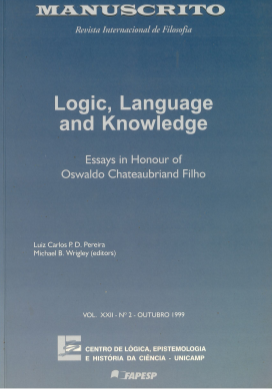Resumen
An interpretation (model) for a first order language is amorphous provided every transformation on its domain is an automorphism. Among amorphous interpretations are all models of the theory of the universal binary relation. Here it is shown that many of the well known model theoristic properties of such examples hold for all amorphous interpretations: (I) that each non-logical constant is definable in the complete theory of an amorphous interpretantion by a boolean combination of quantifier free formulas in a pure identify language; (2) that the complete of an theory of amorphous interpretation admits elimination of quantifiers; (3) that the complete theory of na infinite amorphous interpretation is totally categorical, not finitely axiomatizable, the model completion of ∏0 1 theory, and axiomatizable by its ∏0 1theory and na infinite set of ∑0 1sentences stating that for each in its domain is of cardinality at least n; and (4) that all infinite amorphous interpretations of a first order language with finite non-logical vocabular are quase-finitely axiomatizable.
Citas
Chang, C.C. & Keisler, H.J.(1997). Model Theory (second edition), (Amsterdam).
Clark, D.M. & Krauss, P.H. (1977). Relatively Homogeneous Structure, Logic Colloquium, 76, R.O. Grandy and J.M.E. Hyland (eds.), Amsterdam, pp. 255-282.
Hodges, W. (1993). Model Theory (Cambridge).
Hrushovski, E. (1989). Totally Categorical Structures, Transactions of the American Mathematical Society, 313, pp. 131-159.
Lindenbaum, A. & Tarski, A. (1983). On the Limititations of the Means of Expression of Deduction Theories (1935), (Translation by J.H. Woodger) in Logic, Semantics, Metamathematics (second edition) J. Corcoran (ed.) (Indianapolis), pp. 3384-392.
Robsinson, A. (1963). Model Theory (Amsterdam).
Rosenstein, J.G. (1982). Linear Ordening (New York).
Sacks, G.E. (1972). Saturated Model Theory (Reading).
Tarski, A. (1986). What are Logical Notions? J. Corcoran (ed.)
History and Philosophy of Logic, 1, pp. 143-154.
Tarski, A. & Gaivant, S. (1985). A Formalizaton of Set Theory Without Variables (Providence).
Weaver, G. (1988). Classifying Categorical THeories, Studia Logica, 47, pp. 327-345.
Zil’ber, B.I, (1980). Totally Categorical Theories, Structural Properties and Non-finite Axiomatizability, Model Theory of Algebra and Arithmetic, P.Pacholski, J. Wierzejewski and A.J. Wilkie (eds.), Berlin, pp. 381-410.

Esta obra está bajo una licencia internacional Creative Commons Atribución 4.0.
Derechos de autor 1999 Manuscrito: Revista Internacional de Filosofia

